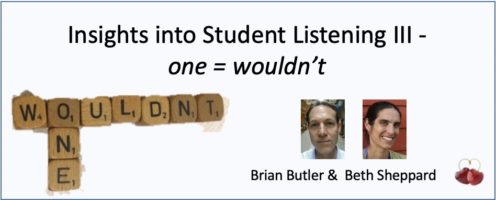49 – Insights into Student Listening – one = wouldn’t
This is the third of three posts in which I discuss issues which arise from Beth Sheppard and Brian Butler’s wonderful research paper Insights into Student Listening from Paused Transcription (Sheppard & Butler 2017). They asked a total of 77 students to write down four-word phrases which had just occurred in a recording: the recording was paused in order that they could write down their versions of the four words.
One particularly interesting result that emerged from the study was that the word wouldn’t in the four-word chunk that wouldn’t seem like had no correct transcriptions: it was omitted by 35 of the 77 participants, the other42 transcribed it as one, was, will, would, want. None of the participants transcribed it ‘correctly’.
Before we go any further, have a listen.
In the four-word phrase that wouldn’t seem like the two syllables of wouldn’t to my ears have a monosyllabic soundshape |wʊn|. What do you think? The extract below consists of the soundshape of wouldn’t on its own.
You have to be careful how you listen. If you approach the recording with the certainty that this is the soundshape of the bi-syllabic form of wouldn’t you will be priming yourself to hear it as consisting of two syllables. If however you listen with naive ears – your starting position is that you attending solely to the sound substance and not on meaning – I think you will agree that it is closer to monosyllabic than bisyllabic.
Personally, I don’t blame the 35 participants who did not transcribe (and presumably did not hear) these syllables. For two reasons: what actually occurs is a monosyllabic soundshape close to |wʊn| (as I have mentioned); and according to my measurements, this soundshape goes at 12.5 syllables per second, whereas the four-word phrase as a whole goes at 6.5 syllables per second. [NB In doing this calculation, I treated wouldn’t as two syllables]. Both speeds are extremely fast: the standard measure of fast speech is ca. 5.3 syllables per second (cf. Cauldwell, 2013: Chapter 7), and wouldn’t is going at more than double this speed.
But 13 of the participants transcribed it as one which again I think is a reasonable hearing: it is a representation of the actual soundshape |wʊn| which is more accurate – in terms of soundshapes – than the ‘correct’ representation given by the spelling wouldn’t with its associated citation-form soundshape of |wʊdᵊnt|.
As with the previous post on the word study, students’ perceptions can guide us expert listeners (teachers and authors) to hear the reality of the sound substance of speech.
We need to respect and value their perceptions. Not least because it is with these perceptions that we should start the process of teaching them about the variability of the sound substance.
Cauldwell, R.T. (2013). Phonology for Listening: Teaching the Stream of Speech. Birmingham: Speech in Action.
Cauldwell, R.T. (2018). A Syllabus for Listening – Decoding. Birmingham: Speech in Action.
Sheppard, B. & Butler, B. (2017). Insights into student listening from paused transcription. CATESOL Journal, 29.2, 81-107


